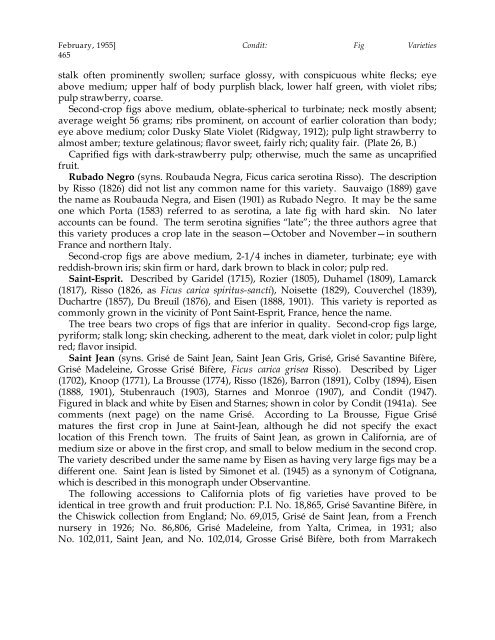Fig Varieties: A Monograph - uri=ucce.ucdavis
Fig Varieties: A Monograph - uri=ucce.ucdavis
Fig Varieties: A Monograph - uri=ucce.ucdavis
You also want an ePaper? Increase the reach of your titles
YUMPU automatically turns print PDFs into web optimized ePapers that Google loves.
February, 1955] Condit: <strong>Fig</strong> <strong>Varieties</strong><br />
465<br />
stalk often prominently swollen; surface glossy, with conspicuous white flecks; eye<br />
above medium; upper half of body purplish black, lower half green, with violet ribs;<br />
pulp strawberry, coarse.<br />
Second-crop figs above medium, oblate-spherical to turbinate; neck mostly absent;<br />
average weight 56 grams; ribs prominent, on account of earlier coloration than body;<br />
eye above medium; color Dusky Slate Violet (Ridgway, 1912); pulp light strawberry to<br />
almost amber; texture gelatinous; flavor sweet, fairly rich; quality fair. (Plate 26, B.)<br />
Caprified figs with dark-strawberry pulp; otherwise, much the same as uncaprified<br />
fruit.<br />
Rubado Negro (syns. Roubauda Negra, Ficus carica serotina Risso). The description<br />
by Risso (1826) did not list any common name for this variety. Sauvaigo (1889) gave<br />
the name as Roubauda Negra, and Eisen (1901) as Rubado Negro. It may be the same<br />
one which Porta (1583) referred to as serotina, a late fig with hard skin. No later<br />
accounts can be found. The term serotina signifies “late”; the three authors agree that<br />
this variety produces a crop late in the season—October and November—in southern<br />
France and northern Italy.<br />
Second-crop figs are above medium, 2-1/4 inches in diameter, turbinate; eye with<br />
reddish-brown iris; skin firm or hard, dark brown to black in color; pulp red.<br />
Saint-Esprit. Described by Garidel (1715), Rozier (1805), Duhamel (1809), Lamarck<br />
(1817), Risso (1826, as Ficus carica spiritus-sancti), Noisette (1829), Couverchel (1839),<br />
Duchartre (1857), Du Breuil (1876), and Eisen (1888, 1901). This variety is reported as<br />
commonly grown in the vicinity of Pont Saint-Esprit, France, hence the name.<br />
The tree bears two crops of figs that are inferior in quality. Second-crop figs large,<br />
pyriform; stalk long; skin checking, adherent to the meat, dark violet in color; pulp light<br />
red; flavor insipid.<br />
Saint Jean (syns. Grisé de Saint Jean, Saint Jean Gris, Grisé, Grisé Savantine Bifère,<br />
Grisé Madeleine, Grosse Grisé Bifère, Ficus carica grisea Risso). Described by Liger<br />
(1702), Knoop (1771), La Brousse (1774), Risso (1826), Barron (1891), Colby (1894), Eisen<br />
(1888, 1901), Stubenrauch (1903), Starnes and Monroe (1907), and Condit (1947).<br />
<strong>Fig</strong>ured in black and white by Eisen and Starnes; shown in color by Condit (1941a). See<br />
comments (next page) on the name Grisé. According to La Brousse, <strong>Fig</strong>ue Grisé<br />
matures the first crop in June at Saint-Jean, although he did not specify the exact<br />
location of this French town. The fruits of Saint Jean, as grown in California, are of<br />
medium size or above in the first crop, and small to below medium in the second crop.<br />
The variety described under the same name by Eisen as having very large figs may be a<br />
different one. Saint Jean is listed by Simonet et al. (1945) as a synonym of Cotignana,<br />
which is described in this monograph under Observantine.<br />
The following accessions to California plots of fig varieties have proved to be<br />
identical in tree growth and fruit production: P.I. No. 18,865, Grisé Savantine Bifère, in<br />
the Chiswick collection from England; No. 69,015, Grisé de Saint Jean, from a French<br />
nursery in 1926; No. 86,806, Grisé Madeleine, from Yalta, Crimea, in 1931; also<br />
No. 102,011, Saint Jean, and No. 102,014, Grosse Grisé Bifère, both from Marrakech
















![Fig Trees in North Carolina [Archive] - IDigMyGarden ... - Figs 4 Fun](https://img.yumpu.com/26905320/1/190x245/fig-trees-in-north-carolina-archive-idigmygarden-figs-4-fun.jpg?quality=85)